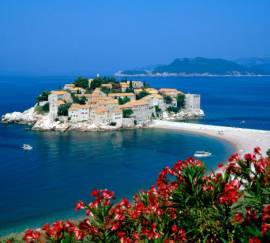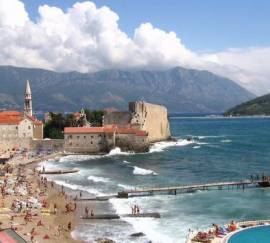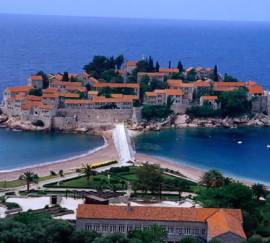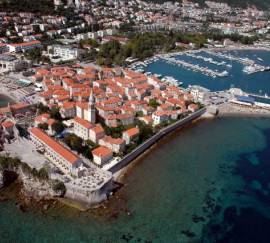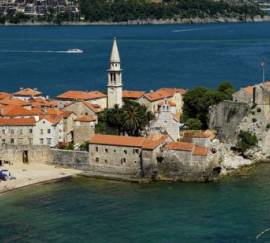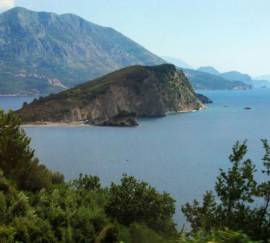BUDVA
Budva is a coastal town in Montenegro. It has around 18,000 (2011) inhabitants, and it is the centre of Budva Municipality. The coastal area around Budva, called the Budvanska rivijera, is the centre of Montenegro's tourism, and is well known for its sandy beaches, diverse nightlife, and examples of Mediterranean architecture. Budva is 3,500 years old, which makes it one of the oldest settlements on the Adriatic Sea coast.
Budva is fenced off from the mainland with mountains. In this region we wil find a typical Mediterranean vegetation. Besides Kotor and Gerceg Novi Budva is the most popular tourist resort in Montenegro. The region of Budva is one of the most commercialised parts of the Montenegrin Adriatic cost. From the top of the mountains extends beautiful view toward the Boudvanska rivijera. Worthy of notice is the Old town of Budva situated on a cape, that was considerably destroyed by the erthquake in 1979.
Few kilometres south east of the city centre there is the island of Sveti Stefan, that is currently used as a luxury hotel.
A legend says that Budva was established by Kadmos, a Phoneician hero, who was expelled from Thebes and who found shelter for himself and his wife Harmonia. However in accordance with the archaeologically researches first (from 4th century BC) was here an Illyrian settlement, later a Greek Buthoe settlement. In 168 BC the town with his neighbourhood was taken over by Rome. During the Roman reign the name of the town was Butua and it was a part of the Illyricum province (in the time of Republic) and later of Dalmatia (in the time of empire). In this time trade and the cultivation of grapevine and olive developed. The biggest prime of the town was in 1st and 2nd century AD. After the fall of the Roman Empire and the splitting in East and West, the town was situated on the border of this two parts, this exerted big influence on the history and culture of the town. In the beginning of the Middle Ages Budva was governed by the Byzantine Empire. In this time to the region of Budva came together with Eurasian Avars came first Slavs. At the turn of 7th and 8th century Budva was governed by dukes of Duklja and later Zeta. The time of the reign of the Emperor Stephen Uroš IV Dušan of Serbia was for Budva a hayday.
The Venetians ruled the town for nearly 400 years, from 1420 to 1797. Budva, called Budua in those centuries, was part of the Venetian Republic region of Albania Veneta and was fortified by powerful Venetian walls against Ottoman conquests. According to the historian Luigi Paulucci in his book "Le Bocche di Cattaro nel 1810" (The Bay of Kotor in 1810), most of the population spoke the Venetian language until the beginning of the nineteenth century. One of the most renowned theater librettists and composers, Cristoforo Ivanovich, was born in Venetian Budua.
In the very turbulent years that followed, Budva saw a change of several of its supreme rulers – Austria, France and Russia. A union of Boka Kotorska (and Budva) with Montenegro took place for a brief period (1813–1814), but from 1814 until 1918 Budva remained under Austrian Empire. After WWI, in 1918 Serbian army entered Budva abandoned by Austrian forces and it came under the Kingdom of Yugoslavia. Later, in 1941, it was annexed by the Kingdom of Italy.
During World War II many people of this area died in the fight between partizans and Axis troops. Budva was finally liberated from Nazi rule on 22 November 1944 and, after belonging once again to Yugoslavia, is now part of the newly independent Montenegro.
A catastrophic earthquake struck Budva on 15 April 1979. Much of old town was devastated, but today there is little evidence of the catastrophe – almost all the buildings were restored to their original form
Places in Budva worth to see:
Old Town - The Old Town in Budva has many different tales and stories of its origin. Scholars and historians believe it to have originally been an island, which later joined the shore to form a sand isthmus. The Old Town, along with the city of Budva was said to have been discovered by a Greek sailor by the name of Boutoua. Eventually the Roman Empire took over the whole Montenegrin coast influencing it greatly.
Much of the architecture in the Old Town is of Venetian design. Doors, hinges, windows, balconies and many other small but noticeable things seem to hold the Roman style of the Republic of Venice. There are also three main churches in the old town. The first is St. Ivan's which was built in the 7th century, second St. Mary's of Punta dating from 840 and the third, The Holy Trinity, which was built in 1804. The Venetian walls of the Old town are a famous tourist attraction.
The Old Town is also famous for the earthquakes it suffered in 1979, where the whole town had to be rebuilt; it took eight years (until 1987) for it to be finished.
Town environs:
The island of St. Nikolai - is one of the biggest islands of the Montenegrin coast (2 km long). The name of the island comes from a small church of St. Nikolai from the 16th century, surrounded by an old cemetery. On the island live a lot of species of birds and small animals. The citizens of Budva call the island Hawaii.


